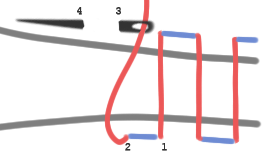 You can sew many lovely plush using just a few stitches. For smooth sewing, I highly recommend Thread Heaven or beeswax for your thread to glide easily through the fabric, and not tangle. :)
You can sew many lovely plush using just a few stitches. For smooth sewing, I highly recommend Thread Heaven or beeswax for your thread to glide easily through the fabric, and not tangle. :)
Running Stitch: A basic stitch. Lengthen stitch length to make a basting stitch.

Sew straight and even lines 2mm away from the raw edge, alternating sides of the fabric. Pull the needle and thread through completely through one side of the fabric, then the other. Repeat, making small even stitches.
Basting Stitch: Same method as a running stitch, but longer stitches. This is commonly used to temporarily hold 2 pieces of fabric together, as it’s more accurate than pins.
Whip Stitch: For edges

Sew tight and even loops perpendicular around the raw edge of the applique fabric to the main fabric. Use a thread color that matches the smaller(top applique) felt piece. Bring the needle up through the right side of applique fabric 1/8″ away from the edge. Insert the needle into the right side of the main fabric piece 1/8″ to the side.
Whip stitch: For applique

Sew tight and even loops perpendicular around both raw edges of fabric.
Back Stitch: A durable stitch

Use 2 strands of thread, stitch from WS to RS of fabric forward, then stitch backwards 2mm. This will be the length of each stitch showing at the right side of the fabric. Stitch forward about 4mm for the next stitch, and then 2mm backwards into the closest edge of the last stitch.
Ladder Stitch: Perfect for hiding your last closure seam, and attaching limbs with hidden stitches.

Shown top view in the diagram, red horizontal stitches are on the wrong side of fabric, inside the plush.
Pick a thread color that matches the area you will sew closed. Thread your needle, and knot. Insert your needle into the wrong side of the fabric at the top of the opening. Keep the same seam allowance as was sewn nearby, and stitch out to the right side of the fabric. Sew into the fabric on the opposite piece with 1/4” seam allowance, make a small stitch, and cross over to the opposite piece of fabric. Repeat, pulling the hole closed with tension on the thread as you sew. If you need to put in more stuffing, do so before the opening closes completely.
Satin Stitch: Hand embroidery stitches used for fills.

The stitches are done using the same method as a running stitch, but are sewn parallel to each other rather than a straight running line. Make sure your threads are very close together so there aren’t horizontal gaps between each satin stitch.
Extra handsewing tips
- Keep stitches tight, but without puckering the fabric.
- Take time to practice making your stitches even. Small and even stitches are most attractive, especially when they’re visible on felt plush. You can use a gingham (checkered) fabric to count the squares for each stitch.
- To easily embroider a design on felt, first draw the design on tissue or wax paper, place the paper over the felt, and sew through the felt and paper together. Simply rip the paper away when done.
- Use good quality upholstery thread for ladder stitching heavier fabric.
- Draw the stitching line on the wrong side of the fabric with washable pen so it’s easy to know where to sew.
